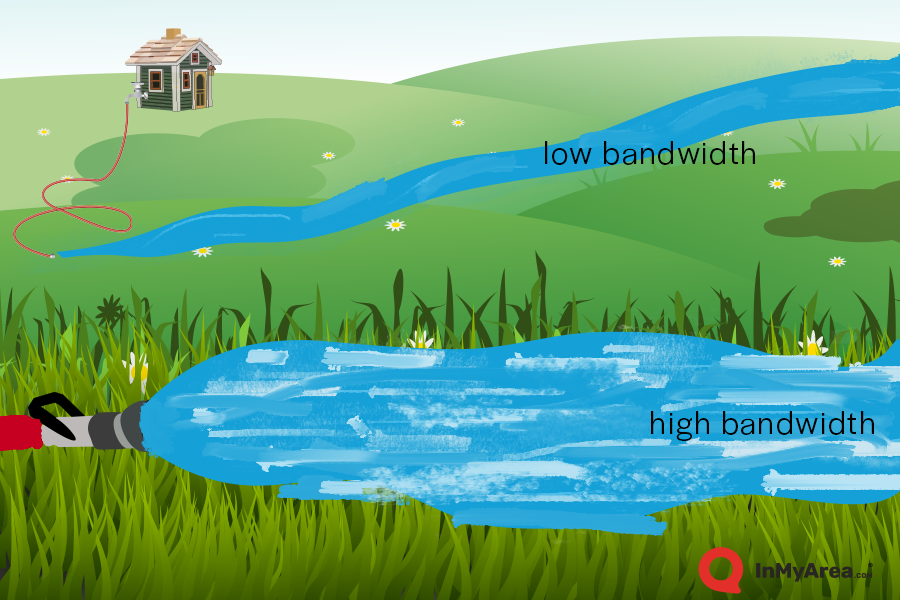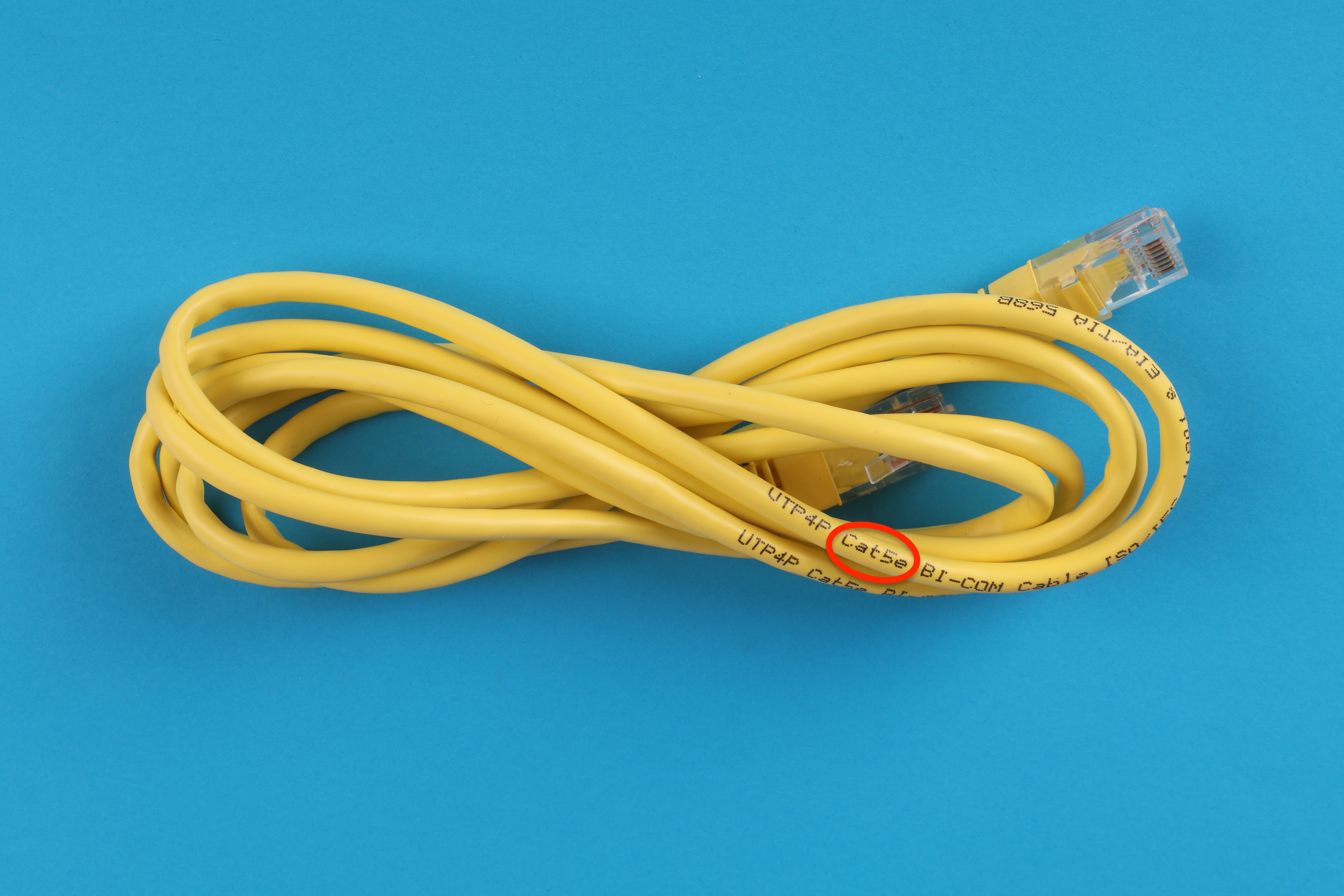When it comes to speed, some people are told the higher the number the better. That can be confusing when 1 Gbps is faster than 100 Mbps. What does this all mean? No one wants slow internet, but what is considered fast internet?
Common internet speed terms defined
What is bandwidth?
Bandwidth is the maximum transfer rate, or maximum speed, that data can travel through an internet connection.
What is Mbps?
Megabits per second (Mbps) is a measure of speed and indicates how much data is transferred in 1 second. Most internet plans will show Mbps to the right of a number (e.g. 50 Mbps, 100 Mbps, 500 Mbps).
What is Gbps?
Gigabit per second (Gbps) is another way to measure speed. When you see “Gbps” in terms of internet speed, it’s an indicator that the internet is extremely fast since 1 Gbps is equivalent to 1,000 Mbps.
Difference between bandwidth and speed

Think of bandwidth and speed as water flowing through a hose. Your hose determines your bandwidth. It can only allow so much water, data, to go through it. A narrow hose has low bandwidth while a wide hose will have high bandwidth.
What is a good internet speed?
The FCC defines broadband as high-speed internet that is a minimum of 25 Mbps download and 3 Mbps upload. You can use the FCC’s definition of broadband as a benchmark for a good internet speed. This speed is good enough for one or two people to do any of their favorite online activities, such as streaming videos.
Generally speaking, anything above 100 Mbps is considered fast internet because it can connect multiple devices at once without much problem. Speeds above 100 Mbps are enough for multiple people to stream Hulu and Netflix or play video games online. Internet with speeds up to 1 Gig/1,000 Mbps is considered ultra-fast and one of the fastest internet speeds available on the market today.
How much speed do I need?
How much speed you need will depend on two different things: the number of users in your household and the types of activities you do online. You want to purchase an internet plan with speeds that can accommodate everyone being online at the same time. Consider the activities the members of your household do online and use the chart below to determine how much internet speed you need.
Download speed | What you can do with this speed | ISPs that offer this speed |
|---|---|---|
3-6 Mbps | Connect 1 device Send emails Browse the web Read articles and blogs Online banking Stream music in high quality Stream videos in SD quality | |
10 Mbps | Connect 1 device Scroll through social media Occasionally download Stream videos in 720p HD quality | |
25 Mbps | Connect 1-2 devices Online shopping Video conferencing Light gaming (except satellite internet) Streaming music Stream videos in 1080p HD quality | |
50 Mbps | Connect 2-3 devices Download files in minutes Online multiplayer gaming (except satellite internet) Stream videos in UHD 4K quality | Frontier Communications Rise Broadband Viasat |
75 Mbps | Connect 3-4 devices Cloud applications Work remotely | AT&T |
100 Mbps | Connect 4-5 devices Download 10 songs in 30 seconds Download 20 photos in 1 minute Download 10 TV episodes in 3 minutes | Frontier Communications AT&T Verizon Fios RCN Sparklight (previously Cable ONE) Windstream Viasat |
200-300 Mbps | Connect 8-15 devices Small smart home system with cameras Seamless online gaming (except satellite internet) Live stream video Large file sharing | AT&T Sparklight (previously Cable ONE) Earthlink MetroNet Cox Communications SuddenLink |
500 Mbps | Connect 20-25 devices Competitive online gaming Large smart home system with many cameras Shave download times from minutes to seconds | Xfinity Metronet RCN Windstream Mediacom |
1 Gig/1 Gbps/1,000 Mbps | Connect 40+ devices Download 10 songs in 3 seconds Download 20 photos in 5 seconds Download 10 TV episodes in 30 seconds Professional online gaming (except satellite internet) | AT&T Spectrum Verizon Fios Xfinity CenturyLink Cox Communications RCN Mediacom Earthlink Windstream |
What is a good download speed?
Download speeds determine how fast you can load content from online. Good download speeds will allow everyone to do their favorite online activities at the same time without any issues. That means if you are streaming a movie on Netflix, other people in your home should be able to use the internet without having to wait too long for things to load. A good download speed will vary from household to household depending on how many people there are and the activities they do online.
Download Speeds Chart
Activity | Time to complete the activity at various speeds |
|---|---|
Download 10 songs | 10 Mbps: 5 minutes 25 Mbps: 2 minutes 50 Mbps: 1 minute 100 Mbps: 30 seconds 500 Mbps: 6 seconds 1000 Mbps: 3 seconds |
Download 20 photos | 10 Mbps: 10 minutes 25 Mbps: 4 minutes 50 Mbps: 2 minutes 100 Mbps: 1 minute 500 Mbps: 12 seconds 1000 Mbps: 6 seconds |
Download 10 TV episodes | 10 Mbps: 30 minutes 25 Mbps: 12 minutes 50 Mbps: 6 minutes 100 Mbps: 3 minutes 500 Mbps: 36 seconds 1000 Mbps: 18 seconds |
What is a good upload speed?
The upload speed is usually the second number you see after the download speed. For example, you might see “100/10 Mbps” where the “100” is the download speed and the “10” is the upload speed. A good upload speed will matter if you like to share photos and videos regularly. If you work from home and need to share large files with your team or use video conferencing frequently will also need a good upload speed.
Upload Speeds Chart
Activity | Time to complete the activity at various speeds |
|---|---|
Upload a 10 minute (500 MB) video in SD | 1 Mbps: 1 hour and 6 minutes 3 Mbps: 22 minutes and 12 seconds 10 Mbps: 6 minutes and 40 seconds 100 Mbps: 40 seconds 500 Mbps: 8 seconds 1000 Mbps: 4 seconds |
How to test your internet speed
If you feel that your internet is slow, take a speed test. You can find free online speed tests, such as the speedtest by Ookla. It takes only 30 seconds to perform a speed test to see how fast your actual download and upload speeds are compared to your advertised speed, and other details like ping. To get the most accurate results, stop any downloads, uploads, streaming or any other internet-heavy activities before using the speed test. The time of day might also affect your speed test results if you’re on a DSL or cable internet connection. These types of internet experience slower speeds in the evening because of network congestion when your neighbors are home streaming Netflix.
Your actual speeds are typically slower than the advertised speeds because you’re paying for speeds “up to.” For example, if you have an internet plan that advertises speeds up to 100 Mbps, your speed test results might be showing that you’re only getting 85 to 95 Mbps. That’s normal because several factors, such as the distance from your home to your ISP or using WiFi instead of a wired connection, can impact your internet speeds.
If your results are coming back slower than 25 Mbps download speed, you might not have fast enough internet to support HD streaming. You can use our simple comparison tool to check if your current internet provider offers faster speeds or if another provider is a better deal on internet speeds.
What is a download manager?
Download managers are often built into your web browser or you can choose to install a program on your computer. Download managers help boost your internet speeds by splitting up a file into smaller chunks to download. For example, downloading a 10 GB file on your computer will suck all of your internet bandwidth and slow down the internet speed on other devices in the house to the point where things are buffering. You can limit the download to take only 10% of the available bandwidth by using a download manager. It would take longer to download the entire file but the download manager would free up bandwidth so that other users in the house can still use the internet without any problems.
4 Things That Could Be Slowing Down Your Internet
Peak hours
Your internet speeds can suffer from internet rush hour when residential users are online at the same time, usually between 7pm and 11pm. Just as a highway can experience traffic when too many cars are on at the same time, the internet can experience network congestion and slower speeds when too many internet users are online at once. This is common among DSL and cable internet connections but not fiber internet.
Your ISP is throttling speeds
Even if your ISP advertises “unlimited data” they can slow down your connection for the rest of your billing cycle after you exceed a certain amount of data. HughesNet, for example, gives all of its satellite internet customers speeds up to 25 Mbps and unlimited data. When you hit the data limit specified in your data plan, HughesNet will reduce speeds to 1-3 Mbps.
An ISP can also throttle speeds if it detects illegal activity, such as torrenting copyrighted content. When a customer uses their ISP’s internet services for such activities, the ISP can get into legal trouble.
Hardware and equipment
Wired connections such as ethernet will always be faster and more reliable than WiFi. Even so, there are improvements in ethernet cords and routers you should check for.
If you’re using an ethernet connection to access the internet, check the print on the ethernet cord. You should see a “Cat” number somewhere. Cat-5 is the oldest but can still perform with speeds up to 100 Mbps, Cat-5e is the most commonly used ethernet cable, and it can support speeds up to 1 Gbps. Cat-6/6a can support speeds up to 10 Gbps. The good news is it’s relatively cheap to get a new ethernet cord if you need to upgrade.

Sometimes we can use the tried-and-true method of rebooting the router when we experience slow speeds. If that fails, there may be other underlying causes of a slow internet connection. The type of router you have can affect your internet speeds. If you’ve had your router for a few years, it’s time to check if it can support your current internet speeds. Our Basics of a Wireless Router Guide can help you understand if you need a new router and how to change its setting to fix issues like WiFi interference.
DNS Server
Domain Name System (DNS) is something that helps your computer or device find the website you’re looking for. People find it a lot easier to remember “Google.com” rather than the IP address that consists of numbers and periods. That’s where a DNS server comes in and translates the website name you type to an IP address of that website.
Your home network usually relies on a DNS server from your internet service provider. The DNS from your ISP can get congested and slow. Switching to a DNS server that’s optimized for efficiency can speed up how fast a webpage takes to load. Google Public DNS and OpenDNS are popular DNS servers. If you want to go this route, the new DNS server will usually have special instructions on how to use their DNS server.
Quick Summary: A good internet speed for you will depend on the activities that you do online. When choosing an internet plan and the amount of speed you need, it’s important to know certain internet terms like bandwidth, Mbps and Gbps. If you’re paying for an internet plan with certain speeds but you’re not actually getting that much speed, there are several possible reasons for the slow down. It’s important to keep your equipment up-to-date and to know the many causes of a slow internet connection, so you can get the best internet speeds possible.


